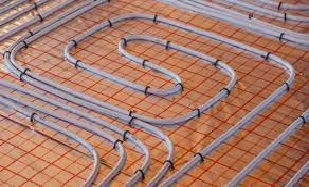Are you a homeowner who’s looking for a new, energy-efficient home heating system for the winter? You may want to consider radiant floor heating!
From reduced energy bills to increased comfort and convenience, there are many benefits of radiant floor heating. In this blog post, we’ll explore how it works and whether or not it’s worth considering for your home.
Read on to learn more about radiant floor heating and its potential cost savings for your home.
What is radiant floor heating, and how does it work?
Radiant floor heating, sometimes called underfloor or in-floor heating, is a method of home heating perfect for those looking to increase comfort and decrease energy bills. It works by running warm water through specialized pipes that are embedded in the flooring. The heat created then radiates throughout the space through convection.
This efficient way of heating a home also has health benefits; as it does not create drafts like many other forms of heating, it prevents pollutants from circulating around the home – leaving homeowners with cleaner air quality inside their homes.
Installation of radiant floor systems begins with covering the area in insulation and a special material that transmits heat well. Then the piping is usually laid before being covered up with the finished flooring – making it an incredibly appealing choice for those building a news home and wanting to update their living space with a tech savvy heating system.
If you want more information on how these systems can work for your house, the professionals at Plumb-Tech will be happy to help you.
Benefits of radiant floor heating
Better air quality
Radiant floor heating is often considered to be healthier than other HVAC systems, as it does not circulate dust and other allergens in the air. Additionally, radiant floor heating can help to reduce respiratory problems, as well as headaches, dry eyes, and nosebleeds.
Increased efficiency
Radiant floor heating is also more efficient than other heat systems, as it does not require the use of a furnace or other mechanical system. Radiant floor heating systems are typically powered by electricity, which can be more expensive to operate than other heating systems.
However, radiant floor heating is often less expensive to install than other types of heating systems (for homes being built).
Increased comfort
Radiant floor heating is also more comfortable than other types of heating, as it evenly distributes heat throughout the room. Additionally, radiant floor heating does not produce drafts like forced-air systems do.
Drawbacks of radiant floor heating
Installation cost and challenges
One of the primary disadvantages of radiant floor heating is the cost. Radiant floor heating systems can be more costly, and the initial cost may deter some homeowners from choosing this type of heating system.
If you already have flooring, the cost of demolition, installation and reinstallation of your flooring
can add up. Radiant floor heating is ideal for new homeowners who are building their houses from scratch, or for others who are installing new flooring.
Inefficiency
Radiant floor heating can be inefficient in some homes. Radiant floor heating relies on heat being conducted through the floors, which can be lost if there are gaps or cracks in the floors. Additionally, radiant floor heating may not be as effective in homes with high ceilings, as the heat may rise before it has a chance to warm the entire room.
Harder to to repair
Finally, radiant floor heating systems can require more maintenance than other heating systems. For example, you may need to bleed the radiators periodically to get rid of air bubbles that have formed in the system.
Cost to install and operate annually?
Installing radiant floor heating in your home is a great way to keep warm and cozy in the colder months, but it’s important to understand the potential cost of installation and operation. Depending on the size of your living space and the complexity of the installation, you can expect installation costs to be around $12 per square foot.
Additionally, depending on the energy source, running a radiant heating system may require more energy than traditional HVAC systems and may incur higher monthly bills.
Ultimately it will depend on the type of system being installed and how it is maintained over time. Be sure to do research and ask professionals about the best radiant heating system for your budget needs!
Conclusion – Is radiant heating worth the investment?
If you’re thinking about radiant heating for your home, it’s important to consider all the factors involved to make sure it’s the right investment for you. Consider installation cost, efficiency, and ongoing maintenance. Radiant heating can often be a great way to save money on your energy bills, but it’s not right for everyone.
If you need more information, contact a local professional to help you determine the best heating solution for your home.
